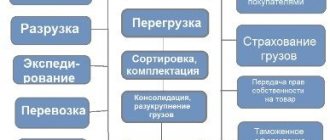Greetings, dear readers of the Tyulyagin project! The word diversification is one of the most common in my articles about investments and economics. And this is not surprising because this concept is often used in the economic and financial sphere. Without understanding the basic terms, it is very difficult to navigate the economic and financial world, including without understanding the meaning of the word diversification. That is why in today’s article I will explain in detail what diversification is , and you will also learn the main types, types and strategies of diversification using real examples.
Diversification - what is it, how and why is it done?
I will explain what diversification is using an everyday example in simple words. Parents, trying to ensure that their child is well-rounded, put a lot of effort into it.
They enroll their son or daughter in a sports section so that the child grows up physically active. They pay for classes with tutors so that the child receives the maximum knowledge. They take them to a music school to introduce the child to art. The list can be endless.
In other words, parents invest money in their child's future. And they do this not in one direction (for example, “focusing” on playing hockey), but choose several paths, confident that the acquired skills will certainly bring dividends in the future. This is called diversification.
Conclusion: diversification is investing in different projects in order to minimize the risk of losses. The concept is used in production, economics, and banking.
Another simple example: Ivanov and Petrov decided to invest their equal cash savings in shares, purchasing them on the stock exchange. Ivanov chose shares of one company, and Petrov bought shares of three companies.
Based on probability theory, Petrov (in comparison with Ivanov) minimized his risk of loss by exactly three times. That is, Petrov diversified his investments, distributing them according to popular wisdom that you cannot put all your eggs in one basket .
The word itself comes from the Latin “diversus” (different) and “facere” (to do). We put the words together and get “ to do different things ”, i.e. literally: expand the range of products, increase the sales market, launch new production facilities, invest in several types of businesses at once, etc.
Main goals of diversification and ways to achieve them
Diversification is a way to minimize risks. And it doesn’t matter what industry this applies to.
What it allows you to achieve :
- receive economic benefit;
- prevent a decline in production and (or) bankruptcy;
- preserve assets even during a crisis.
What can be diversified
Diversification helps optimize any area of business activity.
Let's analyze the use of this tool in some areas in a little more detail.
Strategies
Strategy 1. Related.
A situation where new activities are somehow related to an existing type. For example, a dairy producer buys a farm to provide himself with high-quality raw materials. And the agricultural producer also begins to produce fertilizers.
There are vertical and horizontal related diversification. Vertical – when new business areas are included in the production chain of the main product or service. The examples above illustrate this vertical.
Horizontal can often be observed in the banking sector, when small regional banks are absorbed by larger ones. For development, existing technologies, brand, qualified personnel, etc. are used.
Strategy 2: Unrelated.
The company is expanding its business through the development of new, completely unrelated production and services. For example, a successful mining company begins to develop a banking or construction business.
Prime examples of unrelated diversification are our defense enterprises. When there are no government orders for military products, they produce completely peaceful goods (for example, agricultural or household appliances). In this case, existing technologies and equipment are used.
Strategy 3. Combined.
The golden mean between the two above strategies. The most common option.
Most of the listed types and strategies are the subject of study by economists. For our blog, investment diversification is of greatest interest. I want to dwell on it in more detail.
Diversification of production
There are 2 ways to diversify production:
- Expansion of our own production.
- Purchase of ready-made capacities “on the side”.
The first option is mainly used in the absence of sufficient finance. The company is expanding its production capabilities on its own, investing both its own funds and credit.
The second option is more convenient, but less profitable. Convenient because you can buy production facilities and immediately put them into operation. But if the company does not have enough funds of its own, then the need for large loans arises.
Diversification of production allows you to achieve several goals at once :
- enter other markets or expand existing ones → increase capital turnover → optimize profitability from the company’s business activities;
- reduce dependence on a single sales market or an established product range;
- attract additional categories of consumers;
- stabilize the overall sales of products (the small volume of sales of one type of product is compensated by an increase in sales of another type).
Next, consider the types of production diversification:
Related diversification of production implies a connection between the old business and the new one.
- Vertical – introducing innovations into the existing production chain (from production to sales), for example, opening a network of its own retail outlets, as the Lukoil concern did (a network of gas stations).
This allows the company not to depend on tenants. This type of vertical diversification is called direct.Reverse vertical diversification involves the addition of the functions of a supplier (lower link in the production chain), thus ensuring control over the supply of raw materials.
As an example, we can again cite the concern (what is it?) Lukoil, which carries out a full production cycle: exploration → hydrocarbon production → processing of raw materials → transportation → sales.
- Horizontal – involves expanding the range (nomenclature) of products and (or) developing sales markets in other regions (geographical expansion).
Unrelated production diversification involves the development of production not related to the company's core activities.
- Centered - production of new products not related to the main activity at existing production facilities. For example, the production of “peaceful” products at a military plant.
- Conglomerate (side) – characterized by the company’s penetration into other industries not related to its main activities. Such diversification is carried out by acquiring a third-party enterprise in all respects (fundamentally different). This strategy is characterized by a high degree of risk.
Important: It makes no sense to blindly apply any diversification strategy for a specific company. Only after a comprehensive analysis and analysis of the current situation, as well as after a balanced assessment of options, can you find the optimal way to take the company to a new level.
Key market conditions for implementing a diversification strategy
As mentioned above, a horizontal diversification strategy will require good and proven distribution channels. The company's logistics system must be streamlined and operate continuously. Otherwise, the search for new clients and consumers may divert all the initial income from product sales.
Unlike the technique of quickly increasing income, horizontal diversification takes time to realize the first profits. Often companies, before mastering new technologies, sign contracts with large partners. For example, a chemical production plant can sign an agreement with foreign factories that want to purchase high-quality tires for cars. This way, the plant will have to master rubber manufacturing techniques, but will not have to look for channels for selling these products. Thus, a new niche will be occupied in both domestic and foreign markets.
Diversification of the investment portfolio
Investments (investments in any commercial project with the aim of generating income) imply the presence of risk. That is why the formation of an investment portfolio (set of investments) must be diversified.
And this rule is valid not only for the investment activities of business sharks, but also for those who are just starting their journey as investors.
To minimize risks , it is necessary to use as diverse a list of investment instruments as possible when forming a portfolio. Here are the most relevant ones:
- The currencies of other countries are a popular and easy way to invest even for beginners. Diversification of foreign exchange assets involves investing in the currencies of several countries;
- A deposit in a bank (cash and precious metals) is a safe investment, the disadvantage is a small percentage of income. Beneficial when investing large sums for a long period (from a year). Diversification of deposits involves opening savings deposits in several banks;
- real estate - investments of this kind are profitable only when investing in liquid property (i.e., one that can be quickly sold without loss in price). Diversification of such investments involves the acquisition of various types of real estate (residential and commercial);
- shares - this method of investment is the riskiest of all listed, but also the most profitable. Investing in stocks requires knowledge of basic economics. You can diversify your risks by purchasing shares of several different companies.
Having a diversified investment portfolio, it is very important to constantly keep abreast of all economic news and promptly respond to positive and negative market changes.
Kinds
There are several main types of diversification:
- connected;
- unrelated;
- combined.
Next I will tell you about each type in more detail.
Related
This type involves the creation of additional structures to existing related business areas. This is the most affordable and easiest way to distribute funds and protect against individual risks.
The relationship can be expressed in:
- production activities;
- advertising, sales area;
- management and corporate structure.
Unrelated
The creation of new areas of business operation is considered here. This could be the release of new, radically different products or the development of a new direction that was not integrated in any way with past business processes.
The main disadvantage of this method is the increased costs, because to build a new functional area it is necessary to finance the full production cycle.
Combined
This type is the most common and is a combination of related and unrelated methods. By combining risk protection methods, enterprises can build their business model as efficiently as possible.
Price diversification
This policy is aimed at attracting new customers. This means that prices are changed by the manufacturer (seller) depending on the contingent of consumers .
There are several methods of price differentiation:
- establishing discounts on consumer goods for consumers with low incomes. For example, additional discounts for pensioners at the Pyaterochka chain store;
- fixing special reduced prices (tariffs) for wholesale consumers. For example, reducing electricity tariffs for energy-intensive industries;
- formation of inflated prices for branded consumer goods or services. For example, prices in economy-class beauty salons are significantly different from prices in elite salons of famous brands;
- gradation of prices depending on the obsolescence of the product (service). For example, discounts in clothing stores on last season's collections and increased prices for new models.
The main goal of price diversification is to increase sales volume.











